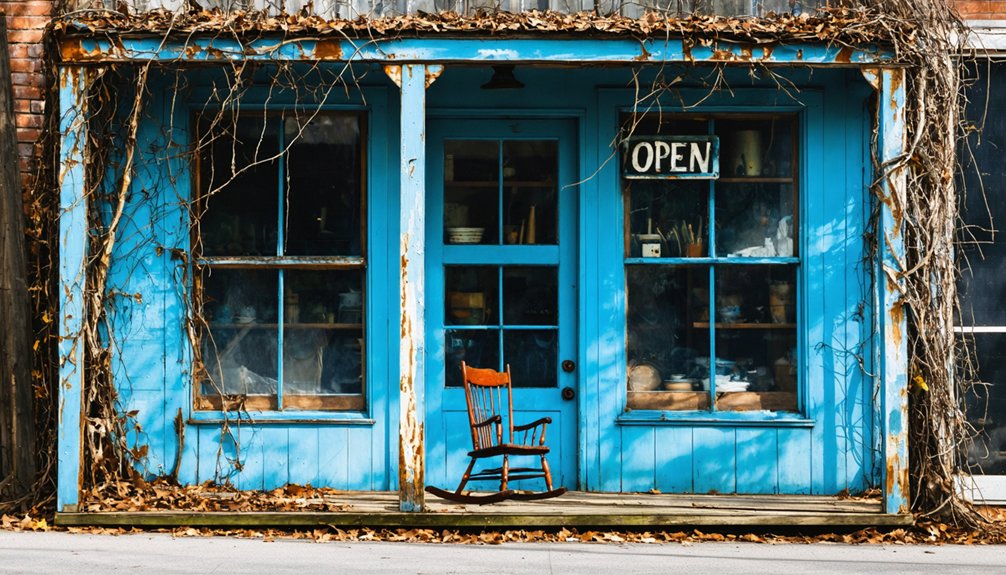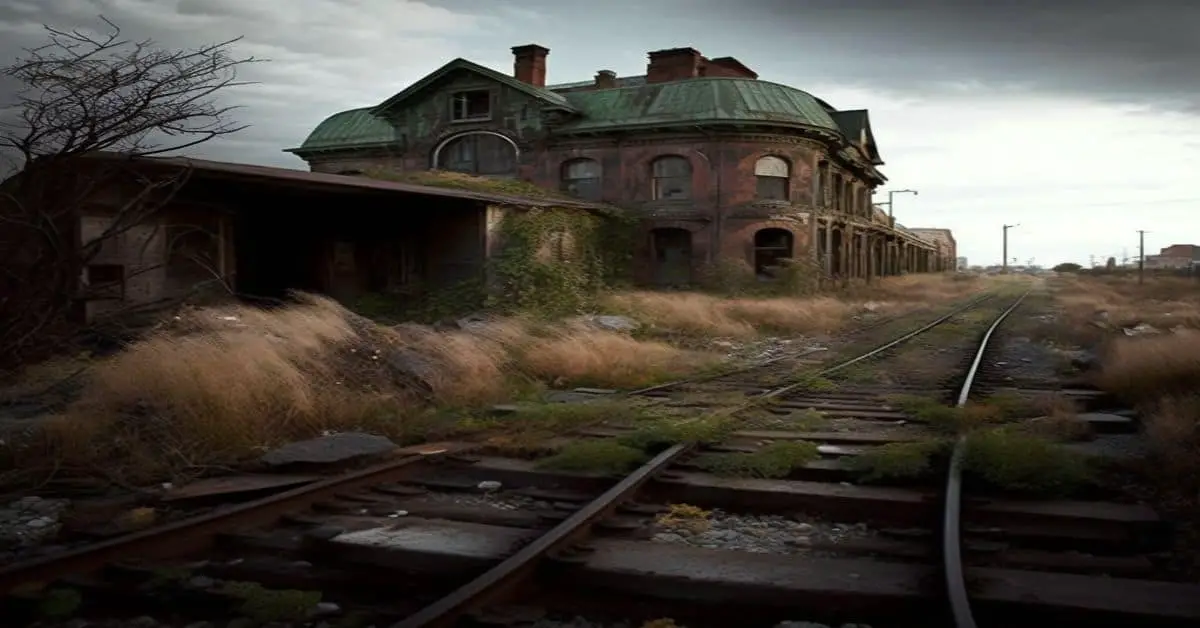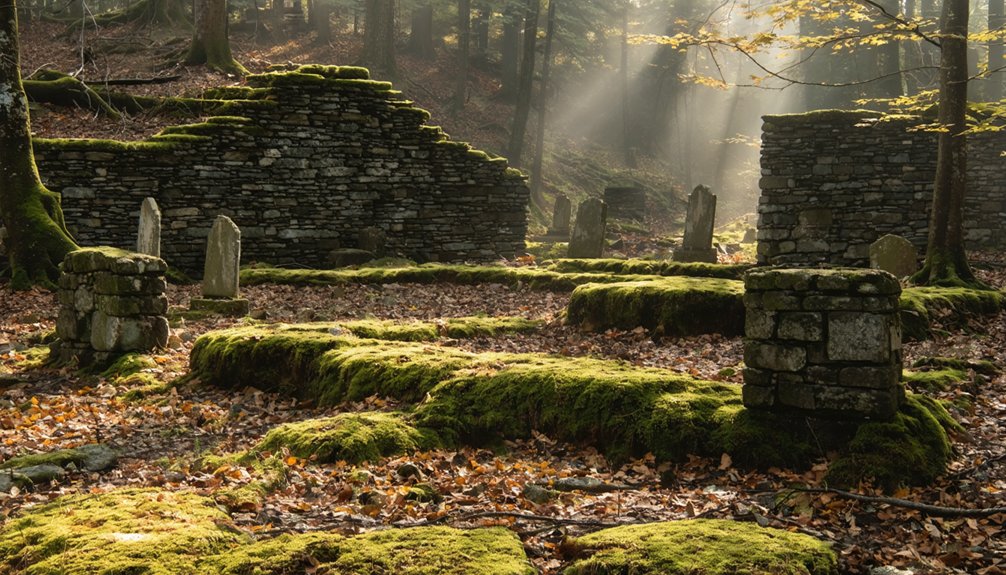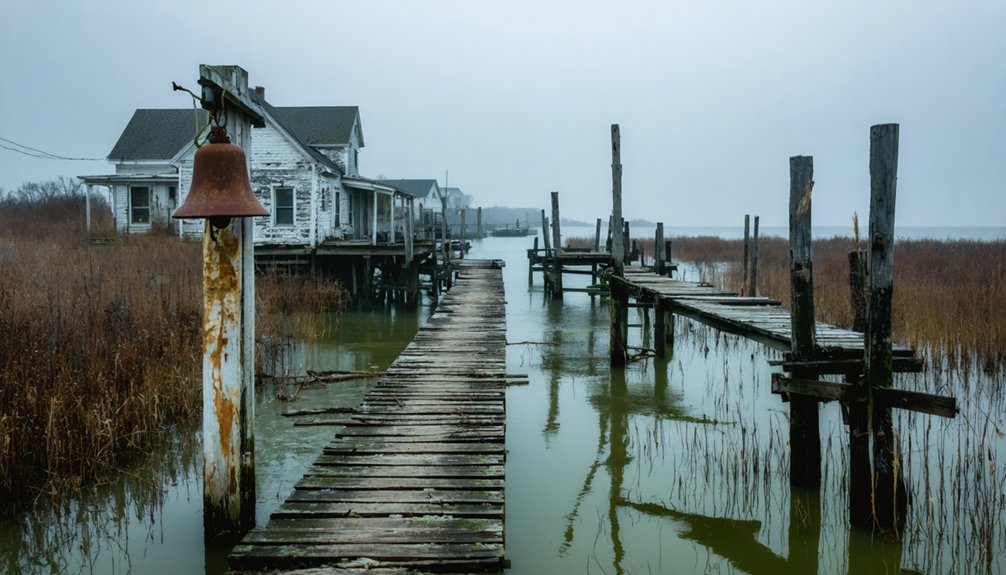You’ll find Bloomfield’s most infamous “ghost town” along an abandoned stretch of Tariffville Road, nicknamed “Evel Knievel Road.” Officially closed in 1984 due to hazardous conditions, this dangerous road features a hundred-foot drop and unstable rock formations. Local folklore tells of a mysterious “ghost car” that vanishes into thin air and unexplained headlights appearing in impassable sections at night. The road’s dark history and supernatural tales have made it a magnet for curious explorers.
Key Takeaways
- Bloomfield, Connecticut is not a ghost town but rather an active suburban community with 21,535 residents and growing economic development.
- The area was first settled in 1660 and has maintained continuous habitation through its evolution from colonial settlement to modern suburb.
- Local ghost stories primarily center around abandoned Tariffville Road (“Evel Knievel Road”), though the road closure was due to safety concerns.
- Despite nearby haunted locations like Dudleytown, Bloomfield itself has no verified reports of paranormal activity or ghost town characteristics.
- The community shows strong vitality with 20,323 jobs, 69% homeownership rate, and $189.2 million in ongoing construction projects.
The Mystery Behind Evel Knievel Road
Along the rugged cliffs of Bloomfield, Connecticut, you’ll find an abandoned stretch of Tariffville Road that earned the ominous nickname “Evel Knievel Road.”
This perilous 14-foot-wide passage, officially closed in July 1984, gained its moniker from local folklore connecting its hazardous nature to the death-defying stunts of America’s famous daredevil. Nearby residents now must collect their mail directly from the Bloomfield post office due to the road closure.
The road’s dangers weren’t just legendary – they were deadly real. Unstable rock layers threatened to collapse into the valley below, while falling boulders regularly littered the narrow pavement. The area was part of an ambitious Route 9 freeway that opened in 1960 but remained isolated despite plans to connect it to I-84.
When repair estimates hit $350,000 in the 1980s (over $1 million today), officials deemed it too costly to save.
Now, this abandoned byway lives on through ghost car stories and urban legends, drawing adventurous explorers who brave the deteriorating cliffside path on foot.
Historical Roots of Bloomfield’s Settlement
While Windsor settlers first ventured into the fertile lands of what would become Bloomfield, it wasn’t until 1660 that the first Indian purchase marked the area’s formal colonization.
The early exploration revealed promising terrain, leading Edward Messenger to build the first home in 1661 at what became known as Messenger Farms. Today, the Greek Revival style Oliver Filley House stands as an enduring reminder of the area’s architectural heritage.
- The Massaco, Tunxis, and Poquonock tribes, all Algonquin divisions, maintained friendly relations with settlers.
- By 1675, numerous families had established homes on the area’s high hills.
- Parish formation in 1736 united parts of Windsor, Farmington, and Simsbury.
- Deep snow and dense forests had previously forced residents to make treacherous journeys to Windsor’s church.
The establishment of Wintonbury Parish marked a turning point, creating a self-sufficient community that would later become Bloomfield. The parish’s initial population consisted of 65 families living across nearly four miles of territory.
Paranormal Encounters and Local Legends
While you’ll find numerous paranormal legends throughout Connecticut, Bloomfield itself has no verified reports of ghostly encounters or supernatural phenomena.
The town’s location near notorious haunted sites like Dudleytown and Dark Entry Forest has led to occasional misattribution of paranormal stories to Bloomfield’s wooded areas and historic farms. Some confusion arises because multiple Dudleytowns exist in different geographical locations across the region. The Dark Entry Forest Association takes preservation seriously, with round-the-clock security patrols monitoring the area.
You won’t find documented evidence of specific hauntings along Evel Knievel Road, in Bloomfield’s forests, or at its agricultural properties, despite the rich supernatural folklore of surrounding Connecticut communities.
Evel Knievel Road Mysteries
Deep within Bloomfield’s abandoned landscape, the mysterious stretch of Tariffville Road known as “Evel Knievel Road” has spawned numerous paranormal tales since its closure in the 1970s.
You’ll find this 14-foot-wide roadway, once connecting Tariffville and Mountain Roads, now stands as a symbol of Connecticut’s forgotten pathways. A hundred-foot drop looms at the edge, making this abandoned road as dangerous as it is mysterious. The area’s remote location and difficult terrain contributed heavily to its abandonment as residents sought more accessible communities.
If you’re brave enough to explore this haunted stretch, you might encounter:
- The infamous “ghost car” that reportedly vanishes into thin air
- Unexplained headlights appearing in impassable sections at night
- Suspended pavement hovering above the river valley
- Deteriorating guardrails being reclaimed by nature
The road’s nickname isn’t just from its treacherous hairpin turns and steep drop-offs – locals claim supernatural occurrences rival any of Evel Knievel’s death-defying stunts, though no formal investigations have confirmed these ghostly encounters.
Ghostly Woods Sightings
Along the misty perimeter of Bloomfield’s abandoned woods, visitors have reported unsettling encounters that rival the mysteries of Evel Knievel Road.
You’ll find yourself drawn into Connecticut’s rich tapestry of paranormal tourism, where ghost sightings echo similar phenomena reported at nearby Dudleytown and Gay City State Park.
Like many of Connecticut’s haunted locations, these woods have become part of local folklore, attracting curious investigators and thrill-seekers. Similar to the mysterious fires that destroyed Gay City’s mills, the woods hold their own dark secrets.
While scientific evidence remains elusive, you’ll discover that many visitors experience unexplained sensations and visual phenomena among the trees.
The area’s historical context adds depth to these encounters, connecting them to broader patterns of paranormal activity across Connecticut’s abandoned settlements and mysterious woodlands.
Some locals even capitalize on these legends, turning their hometown’s spooky reputation into a unique cultural attraction.
The atmosphere feels particularly eerie due to the lack of sunlight filtering through the dense forest canopy, reminiscent of Dudleytown’s Dark Entry Forest.
Historic Farm Apparitions
Unlike the spectral encounters in Bloomfield’s misty woodlands, the town’s historic farms present a different kind of historical intrigue.
While ghostly encounters aren’t documented at these agricultural landmarks, you’ll find rich historical stories that spark the imagination.
- The Francis Gillette House, with its Underground Railroad connections, holds untold stories of secret passages and midnight escapes.
- Gun Mill Road’s hidden musket factory whispers tales of Revolutionary War intrigue.
- The Stone Farmhouse, built by Captain Oliver Filley, stands as a symbol of early American craftsmanship.
- Auer Farm’s brick barn, now part of the 4-H Center, carries echoes of Beatrice Fox Auerbach’s innovative farming legacy.
Though farm legends may be scarce, these historic properties preserve memories of courage, innovation, and American resilience that are far more compelling than any ghost story.
Natural Landscape and Geographical Features
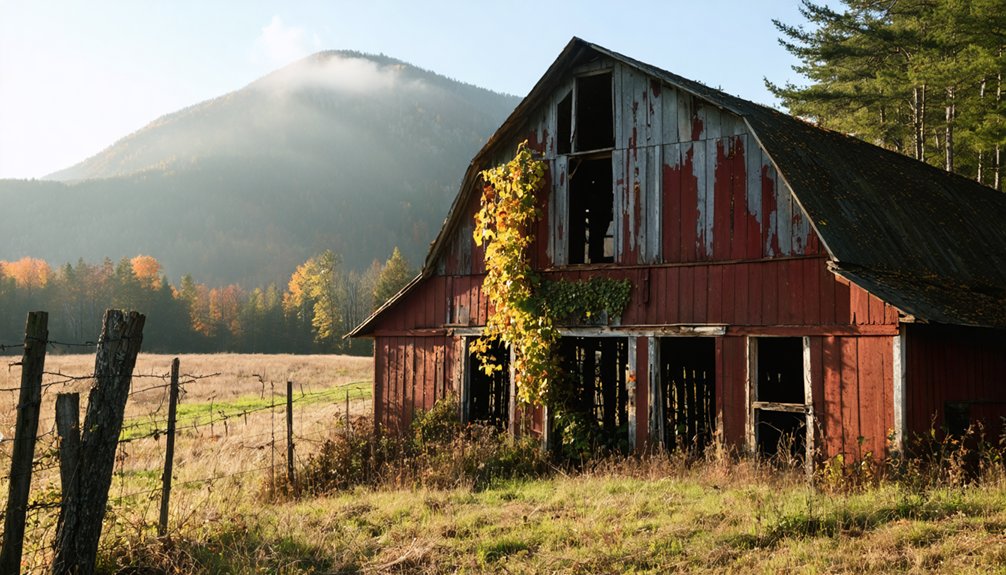
Situated in Hartford County, Connecticut, Bloomfield’s natural landscape showcases a diverse terrain of wooded areas, rolling hills, and valleys that stretch toward the Farmington River.
You’ll find a rich tapestry of natural habitats throughout the region, from dense forests teeming with wildlife to serene streams and scattered ponds.
As you explore the area, you’ll witness dramatic seasonal changes that transform the landscape. Spring brings new growth to the woodlands, while summer’s warmth draws wildlife to the river’s edge.
Fall paints the forests in vibrant colors, and winter blankets the rolling terrain in snow. The varied topography and mix of rural and suburban environments create unique microclimates, supporting diverse ecosystems that you can discover throughout the year.
Preservation of Colonial Architecture
You’ll find remarkable examples of colonial craftsmanship in the surviving 18th-century homesteads of Bloomfield, where thick masonry walls and modest room layouts showcase traditional building techniques.
At the Oliver Filley House (130 Mountain Avenue) and Francis Gillette House (545 Bloomfield Avenue), local fieldstone construction and Greek Revival elements demonstrate how early settlers maximized both form and function.
The preservation of original materials and architectural details in these structures, from multi-pane windows to gabled roofs, provides valuable insights into colonial-era building methods and restoration approaches.
Historical Homestead Restoration Techniques
When restoring colonial-era homesteads in Bloomfield’s ghost town, preservationists follow strict guidelines to maintain architectural authenticity while guaranteeing structural integrity.
You’ll find that historic techniques focus heavily on using period-appropriate materials and traditional craftsmanship to overcome restoration challenges.
- You’ll need to match original lime-based mortars for brick repointing, guaranteeing both durability and historical accuracy in the structure’s foundation.
- Expert craftsmen trained in colonial-era methods will restore woodwork using authentic joinery and historically accurate wood species.
- You must document all repairs with advanced tools like FTIR spectroscopy and SEM-EDX to verify material authenticity.
- You can integrate subtle reinforcements behind surfaces to prevent structural issues without compromising the homestead’s historic character.
Traditional methods combined with modern diagnostic tools guarantee these Connecticut homes retain their colonial essence while meeting modern safety standards.
Colonial Building Material Analysis
Timber dominates the architectural landscape of colonial Bloomfield‘s ghost town, reflecting the abundant forests that early Connecticut settlers relied upon for construction.
You’ll notice the distinctive timber framing techniques derived from English traditions, including large beams with decoratively carved shoulders and central chimney plans that showcase the settlers’ resourcefulness.
As you explore the ghost town’s structures, you’ll find evidence of the region’s evolving building practices.
While early homes used split logs with clay infill, brick production in nearby Windsor revolutionized construction after 1675. The rich local clay deposits enabled the creation of durable bricks, particularly important for chimney construction.
The town’s architectural evolution is visible in the shift from simple log cabins to more sophisticated timber-framed homes featuring saltbox and gambrel roof styles, designed to efficiently shed New England’s harsh weather.
Agricultural Heritage and Development
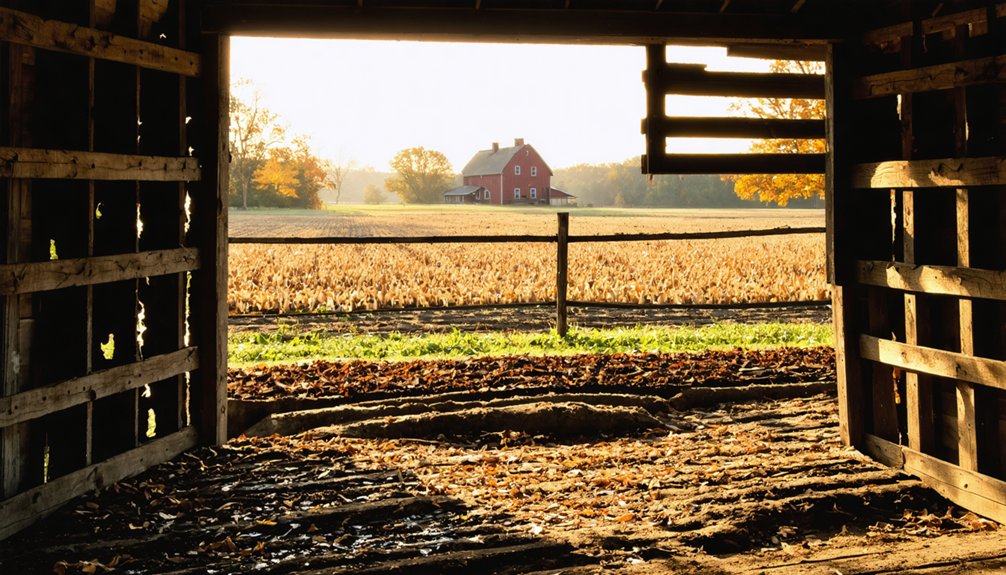
Although Bloomfield began as part of Windsor in 1660, its agricultural roots quickly established the foundation for centuries of farming innovation.
From subsistence farming to commercial production, you’ll discover rich agricultural traditions spanning tobacco, dairy, and mixed farming operations that shaped the region’s identity.
- You can trace the evolution from open-field farming of wheat, rye, and corn to advanced agricultural methods including crop rotation and field preparation.
- You’ll find historic evidence of farm innovation at Auer Farm, recognized in 1950 as a model facility for dairy, poultry, and orchards.
- You’ll see preserved 19th-century barns and outbuildings that showcase traditional farming infrastructure.
- You can explore the Farm Implement Museum’s collection of antique tools, revealing the progression of farming innovations from man-powered to mechanized equipment.
Modern Growth and Community Evolution
Since its transformation from a farming community, Bloomfield has evolved into a diverse suburban hub of 21,535 residents, where 68% are people of color.
You’ll find a thriving community where homeownership exceeds state averages at 69%, though 37% of households face cost burdens from housing expenses.
The town’s economic landscape shows promising community growth, with 20,323 jobs centered in finance and insurance.
You can witness ongoing demographic changes through $189.2 million in construction projects and ambitious downtown redevelopment efforts.
While the median household income of $81,354 sits slightly below Connecticut’s average, the town’s commitment to commercial expansion and sustainable development signals a progressive vision.
The 88% high school graduation rate and steady population growth of 5% since 2010 reflect Bloomfield’s successful evolution into a forward-looking suburb.
Frequently Asked Questions
Are There Any Documented Native American Burial Grounds in Bloomfield?
You won’t find any documented Native American burial grounds in Bloomfield, despite the area’s historical significance. While burial customs were important regionally, no verified sites or land disputes exist within town boundaries.
What Happened to the Original Businesses Along Main Street?
You’re barking up the wrong tree – historical records don’t show a traditional Main Street business district in early Bloomfield. The community evolved from farmland directly into modern suburban development.
When Was the Last Reported Paranormal Activity on Evel Knievel Road?
You won’t find verified Evel Knievel sightings or paranormal investigations past December 2020. While locals share ghost stories, official records show no confirmed supernatural activity since the road’s 1970s closure.
Which Original Colonial Families Still Have Descendants Living in Bloomfield Today?
While 365 residents lived here in 1736, you can’t definitively identify which colonial families remain today, as no extensive database tracks family lineage. Individual genealogical research would be needed to confirm colonial heritage.
Were There Any Significant Natural Disasters That Affected Bloomfield’s Early Development?
You’ll find the 1936 flood had major impacts on early Bloomfield’s development, causing significant property damage along river valleys, though records don’t show any devastating fires affecting colonial settlements.
References
- https://newenglandwithlove.com/ghost-towns-in-connecticut/
- https://boltoncthistory.org/ghosts-of-bolton-past-and-present/
- https://www.americanhauntingsink.com/dudleytown
- https://www.youtube.com/watch?v=kkW6UpOYW5w
- https://en.wikipedia.org/wiki/Dudleytown
- https://en.wikipedia.org/wiki/List_of_ghost_towns_in_Connecticut
- https://ctvisit.com/articles/ghost-hunting-in-connecticut
- https://www.kurumi.com/roads/ct/woodsriver.html
- https://www.youtube.com/watch?v=V-E6fgKtV8g
- https://www.youtube.com/watch?v=0tDipuOPrxg
